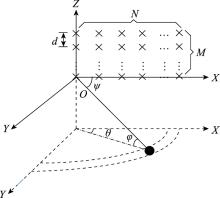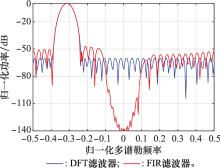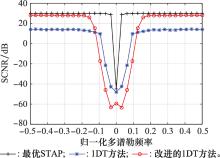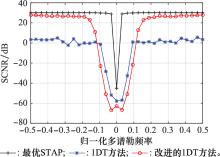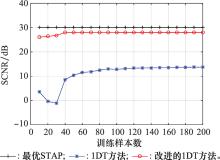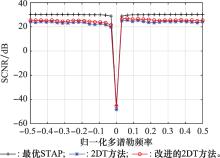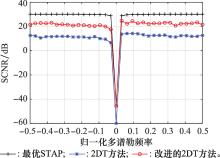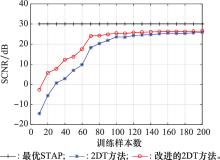Systems Engineering and Electronics ›› 2022, Vol. 44 ›› Issue (1): 86-93.doi: 10.12305/j.issn.1001-506X.2022.01.12
• Sensors and Signal Processing • Previous Articles Next Articles
Reduced-dimension space-time adaptive processing method based on the covariance fitting criterion
Xiaojiao PANG, Yongbo ZHAO*, Chenghu CAO, Yili HU, Sheng CHEN
- National Laboratory of Radar Signal Processing, Xidian University, Xi'an 710071, China
-
Received:2020-10-20Online:2022-01-01Published:2022-01-19 -
Contact:Yongbo ZHAO
CLC Number:
Cite this article
Xiaojiao PANG, Yongbo ZHAO, Chenghu CAO, Yili HU, Sheng CHEN. Reduced-dimension space-time adaptive processing method based on the covariance fitting criterion[J]. Systems Engineering and Electronics, 2022, 44(1): 86-93.
share this article
| 1 | BRENNAN L E , REED I S . Theory of adaptive radar[J]. IEEE Trans.on Aerospace and Electronic Systems, 1973, 9 (2): 237- 252. |
| 2 |
WANG H , CAI L J . On adaptive spatial-temporal processing for airborne surveillance radar systems[J]. IEEE Trans.on Aerospace and Electronic Systems, 1994, 30 (3): 660- 670.
doi: 10.1109/7.303737 |
| 3 | KLEMM R . Space-time adaptive processing-principles and applications[M]. London: the Institute of Electrical Engineers, 2002: 101- 104. |
| 4 |
廖桂生, 保铮, 张玉洪, 等. 阵元幅相误差对AEW雷达二维杂波谱的影响[J]. 电子学报, 1994, 22 (3): 116- 118.
doi: 10.3321/j.issn:0372-2112.1994.03.022 |
|
LIAO G S , BAO Z , ZHANG Y H , et al. On 2-D clutter spectra for AEW radars with imperfect arrays[J]. Acta Electronica Sinica, 1994, 22 (3): 116- 118.
doi: 10.3321/j.issn:0372-2112.1994.03.022 |
|
| 5 |
保铮, 廖桂生, 吴仁彪, 等. 相控阵机载雷达杂波抑制的时-空二维自适应滤波[J]. 电子学报, 1993, 21 (9): 1- 7.
doi: 10.3321/j.issn:0372-2112.1993.09.001 |
|
BAO Z , LIAO G S , WU R B , et al. 2-D temporal-spatial adaptive clutter suppression for phased array airborne radar[J]. Acta Electronica Sinica, 1993, 21 (9): 1- 7.
doi: 10.3321/j.issn:0372-2112.1993.09.001 |
|
| 6 |
MELVIN W L . A stap overview[J]. IEEE Aerospace and Electronic Systems Magazine, 2004, 19 (1): 19- 35.
doi: 10.1109/MAES.2004.1263229 |
| 7 | 周延, 冯大政, 朱国辉, 等. 空域数据分解的两级降维自适应处理方法[J]. 电子与信息学报, 2015, 37 (2): 334- 338. |
| ZHOU Y , FENG D Z , ZHU G H , et al. Two-stage reduced-dimension adaptive processing method based on the spatial data decomposition[J]. Journal of Electronics & Information Technology, 2015, 37 (2): 334- 338. | |
| 8 |
SHEN M W , ZHANG Q , LI J F , et al. Improved application of space-time adaptive monopulse to joint domain localized STAP[J]. Remote Sensing Letters, 2019, 10 (6): 536- 544.
doi: 10.1080/2150704X.2019.1577998 |
| 9 | ZHOU Y , WANG L , CHEN X X , et al. An improving EFA for clutter suppression by using the persymmetric covariance matrix estimation[J]. Circuits, Systems, and Signal Processing, 2018, 37 (2): 4136- 4149. |
| 10 | ZHOU Y , FENG D Z , ZHU G H , et al. The post-Doppler adaptive processing method based on the spatial domain reconstruction[J]. Signal Processing, 2015, 9 (2): 89- 93. |
| 11 |
DEGURSE J F , SAVY L , MARCOS S . Reduced-rank STAP for target detection in heterogeneous environment[J]. IEEE Trans.on Aerospace and Electronic Systems, 2014, 50 (2): 1153- 1162.
doi: 10.1109/TAES.2014.120414 |
| 12 | WANG Y L , LIU W J , XIE W C , et al. Reduced-rank space-time adaptive detection for airborne radar[J]. Science China Information Sciences, 2014, 57 (8): 082310. |
| 13 | LIU W J , XIE W C , LI R F , et al. Adaptive detectors in the Krylov subspace[J]. Science China Information Sciences, 2014, 57 (10): 102310. |
| 14 |
WU Q , ZHANG Y M , MOENESS G A , et al. Space-time adaptive processing and motion parameter estimation in multistatic passive radar using sparse Bayesian learning[J]. IEEE Trans.on Geoscience and Remote Sensing, 2016, 54 (2): 944- 957.
doi: 10.1109/TGRS.2015.2470518 |
| 15 |
HAN S D , FAN C Y , HUANG X T . A novel STAP based on spectrum-aided reduced-dimension clutter sparse recovery[J]. IEEE Geoscience and Remote Sensing Letters, 2017, 14 (2): 213- 217.
doi: 10.1109/LGRS.2016.2635104 |
| 16 |
GUO Y D , LIAO G S , FENG W K . Sparse representation based algorithm for airborne radar in beam-space post-Doppler reduced-dimension space-time adaptive processing[J]. IEEE Access, 2017, 5, 5896- 5903.
doi: 10.1109/ACCESS.2017.2689325 |
| 17 |
DUAN K Q , WANG Z T , XIE W C , et al. Sparsity-based STAP algorithm with multiple measurement vectors via sparse Bayesian learning strategy for airborne radar[J]. IET Signal Processing, 2017, 11 (5): 544- 553.
doi: 10.1049/iet-spr.2016.0183 |
| 18 |
SU Y Y , WANG T , TAO F Y , et al. A gird-less total variation minimization-based space-time adaptive processing for airborne radar[J]. IEEE Access, 2020, 8, 29334- 29343.
doi: 10.1109/ACCESS.2020.2972366 |
| 19 |
LI Z Y , WANG T . ADMM-based low-complexity off-grid space-time adaptive processing methods[J]. IEEE Access, 2020, 8, 206646- 206658.
doi: 10.1109/ACCESS.2020.3037652 |
| 20 |
YUAN H D , XU H , DUAN K Q , et al. Sparse Bayesian learning-based space-time adaptive processing with off-grid self-calibration for airborne radar[J]. IEEE Access, 2018, 6, 47296- 47307.
doi: 10.1109/ACCESS.2018.2866497 |
| 21 |
DUAN K Q , YUAN H D , XU H , et al. Sparsity-based non-stationary clutter suppression technique for airborne radar[J]. IEEE Access, 2018, 6, 56162- 56169.
doi: 10.1109/ACCESS.2018.2873021 |
| 22 |
LI Z H , ZHANG Y S , HE X Y , et al. Low-complexity off-grid STAP algorithm based on local search clutter subspace estimation[J]. IEEE Geoscience and Remote Sensing Letters, 2018, 15 (12): 1862- 1866.
doi: 10.1109/LGRS.2018.2865536 |
| 23 |
FENG W K , GUO Y D , ZHANG Y S , et al. Airborne radar space time adaptive processing based on atomic norm minimization[J]. Signal Processing, 2018, 148, 31- 40.
doi: 10.1016/j.sigpro.2018.02.008 |
| 24 |
SUN G H , HE Z S , TONG J , et al. Knowledge-aided covariance matrix estimation via Kronecker product expansions for airborne STAP[J]. IEEE Geoscience and Remote Sensing Letters, 2018, 15 (4): 527- 531.
doi: 10.1109/LGRS.2018.2799329 |
| 25 |
谷泓, 赵永波, 张守宏. 一种基于数字综合算法的MTD滤波器设计方法[J]. 航空计算技术, 2002, 32 (2): 58- 61.
doi: 10.3969/j.issn.1671-654X.2002.02.018 |
|
GU H , ZHAO Y B , ZHANG S H . A design method of MTD filters based on the numerical synthesis algorithm[J]. Aeronautical Computer Technical, 2002, 32 (2): 58- 61.
doi: 10.3969/j.issn.1671-654X.2002.02.018 |
|
| 26 |
BESSON O , STOICA P . Decoupled estimation of DOA and angular spread for spatially distribution sources[J]. IEEE Trans.on Signal Processing, 2000, 48 (7): 1872- 1882.
doi: 10.1109/78.847774 |
| 27 |
YANG Z , XIE L H , ZHANG C S . A discretization-free sparse and parametric approach for linear array signal processing[J]. IEEE Trans.on Signal Processing, 2014, 62 (19): 4959- 4973.
doi: 10.1109/TSP.2014.2339792 |
| 28 | GRANT M, BOYD S. CVX: matlab software for disciplined convex programming[EB/OL]. [2020-10-15]. http://stanford.edu/~boyd/cvx. |
| 29 | TAL A B , NEMIROVSKI A . Lectures on modern convex optimization: analysis, algorithms, and engineering applications[M]. Philadelphia: Society for Industrial and Applied Mathematics, 2001. |
| [1] | Yuzhuo WANG, Shengqi ZHU, Ximin LI, Lan LAN. Range ambiguous clutter suppression for FDA MIMO bistatic radar with main lobe correction [J]. Systems Engineering and Electronics, 2022, 44(5): 1483-1494. |
| [2] | Hai LI, Weijie CHENG, Ruijie XIE. Wind speed estimation of low-altitude wind-shear based on homotopy sparse STAP [J]. Systems Engineering and Electronics, 2022, 44(4): 1174-1181. |
| [3] | Wenjing LI, Zhuolin LI, Zhentao YUAN. Sea clutter suppression and target extraction algorithm based on sparse reconstruction [J]. Systems Engineering and Electronics, 2022, 44(3): 777-785. |
| [4] | Mingze WANG, Wei LI, Junwei MA, Xiangping LI. Clutter suppression algorithm based on pixel vector elimination in through-the-wall radar [J]. Systems Engineering and Electronics, 2022, 44(3): 827-833. |
| [5] | Xingjia YANG, Keqing DUAN, Xiang LI, Wei QI. Resolving range ambiguity for cooperative detection using UAV swarms [J]. Systems Engineering and Electronics, 2022, 44(2): 480-489. |
| [6] | Yanling SHI, Lei WANG, Junhao LI. CFAR detection for small targets on sea surface based on singular value decomposition in projection space [J]. Systems Engineering and Electronics, 2022, 44(2): 512-519. |
| [7] | Xiaozhou CHEN, Qingjun XING, Lidong ZHANG. Slow-time-frequency-modulation jamming method forSTAP airborne early-warning radar [J]. Systems Engineering and Electronics, 2021, 43(11): 3177-3184. |
| [8] | Yuqi LIU, Xianrong WAN, Jianxin YI, Hengyu KE. Clutter suppression method for passive radar based on channel Doppler characteristic [J]. Systems Engineering and Electronics, 2021, 43(1): 55-61. |
| [9] | Yanhui ZHAO, Jianlong TANG, Jiyang LI, Luhao BI. Analysis of time-delay aliasing transmission jamming method for reduced dimension STAP airborne radar [J]. Systems Engineering and Electronics, 2020, 42(8): 1718-1725. |
| [10] | Mingming TIAN, Guisheng LIAO, Yunpeng LI, Shengqi ZHU. Clutter properties and suppression method of hypersonic platform radar [J]. Systems Engineering and Electronics, 2020, 42(2): 301-308. |
| [11] | Hao XIAO, Tong WANG, Cai WEN, Yuyu SU. Iteration-separable clutter suppression method for airborne planar array radar [J]. Systems Engineering and Electronics, 2020, 42(11): 2461-2470. |
| [12] | Ziwei DONG, Jun SUN, Jingming SUN, Meiyan PAN. Marine weak moving target detection based on sparse dictionary learning [J]. Systems Engineering and Electronics, 2020, 42(1): 30-36. |
| [13] | PANG Xiaojiao, ZHAO Yongbo, CAO Chenghu, XU Baoqing, CHEN Sheng. Space-time processing method with temporal adaptive FIR filters [J]. Systems Engineering and Electronics, 2019, 41(12): 2669-2674. |
| [14] | GUO Pengcheng, LIU Zheng, LUO Dingli. Radar HRRP clutter robust target recognition method based on double anomaly detection [J]. Systems Engineering and Electronics, 2019, 41(10): 2221-2226. |
| [15] | XU Le, WU Riheng, ZHANG Xiaofei. 2D-DOA and frequency estimation for L-shaped array via reduced-dimensional MUSIC [J]. Systems Engineering and Electronics, 2019, 41(1): 1-8. |
| Viewed | ||||||
|
Full text |
|
|||||
|
Abstract |
|
|||||
